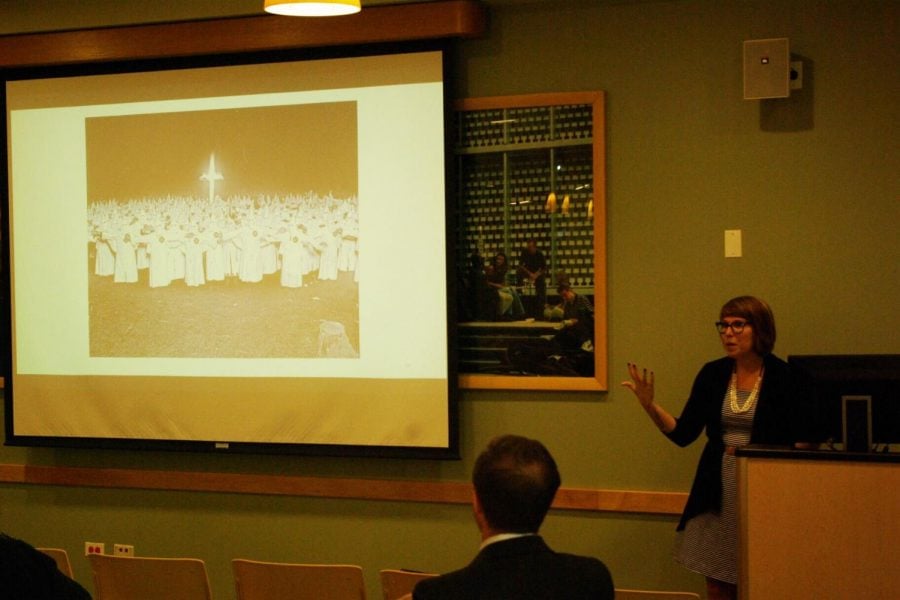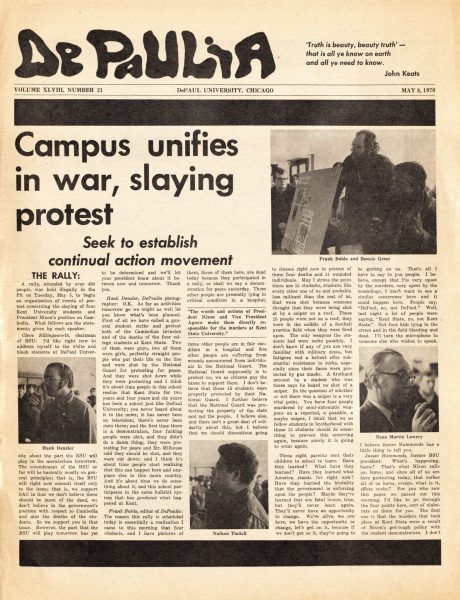Speaker illuminates religious foundations of KKK artifacts
Kelly Baker says burning crosses has double symbolism, both that Christ is the light of the world, and as a warning to minorities or other religions.
KImages of the Ku Klux Klan, its members clad in hooded white robes and standing alongside burning crosses, are often used as shorthand symbols for an almost otherworldly form of American white nationalism and white supremacy – and they shouldn’t be, according to Kelly Baker, an independent scholar, researcher, editor and author of the 2011 nonfiction book “Gospel According to the Klan: The KKK’s Appeal to Protestant America, 1915-1930.”
Drawing on the research she did for her book, Baker gave a lecture on the second floor of the Lincoln Park Student Center on Wednesday, as part of a speaker series sponsored by the Center for Religion, Culture and Community. It was the final lecture of the academic year and the final one under the leadership of associate professor Thomas O’Brien, who will be replaced as the Center’s director by associate professor Chris Tirres next year.
The talk, entitled “The Artifacts of White (Religious) Nationalism,” discussed how modern day white supremacist movements can be understood in the context of the Klan’s historical links to Protestantism, as well as through three of its most valued symbols: the white hood, the fiery cross and the American flag itself.
Baker began by explaining that her focus was on the second order of the Ku Klux Klan, which existed from 1915 to 1930 and was distinct from the violent first order that existed from 1865-1870. The latter was the main inspiration for the adoring portrayals depicted in the controversial, but historically important 1915 silent film “The Birth of a Nation” directed by D.W. Griffiths.
The Klan’s second iteration was founded by William J. Simmons, an ex-Methodist minister and fraternal organizer. By 1924, the group had 4 million members across all 48 continental states while its auxiliary arm, “Women of the Klan,” had half a million members. This included a wide cross-section of American society, from lawyers to bakers to political officials.
The group preached message of “popular nativism,” one that had a “desire for desire for white homogenous Protestant America, free from the corrupting influence of diversity, whether it was political, religious or racial,” according to Baker.
This new Klan looked to the past in order to craft its identity; they returned to the use of white robes, which originally represented the “ghosts of Confederate dead” who had died in the Civil War.
But the meaning soon changed to incorporate religious connotations, Baker said, and the Klan began to view their robes as sacred objects. They saw themselves as “Christian knights” who were “beyond the violence of a previous order.” And the spectral nature of their visage weirded out members of the public, many of whom recognized the regalia as the tools of intimidation they were secretly meant to be.
Next Baker discussed the significance of the American flag to the Klan, which she said many people tend to forget. To a hate group that was terrified of a rising Catholic voting bloc and increased immigration at the beginning of the 20th century, the flag was “a symbol of exclusion,” a constant reminder of the Klan’s belief that “God was a requirement for citizenship, and Protestantism (was) essential to Americanism.”
As she projected a black-and-white archival photo of women members of the Klan, standing beside burning crosses in high heels and nylons, Baker explained that the burning cross was an invention of the early-20th century version of the Klan; it didn’t exist for the Klan during Reconstruction.
While many Protestants “saw the cross as a symbol of Romanism and Catholicism,” the Klan ironically made it one of their sacred symbols, drawing a line from the fire to the idea “that Christ was the light of the world.” Its double meaning was as a “warning to those who the order claimed were threats,” such as African-Americans, Catholics and other non-Protestant religious and ethnic minorities.
In the present day, Baker said, these artifacts of the Klan – robe, flag, burning cross – don’t have as much to do with Protestantism as they did in the early 20th century. The Klan’s numbers are also greatly diminished, with other white nationalist, white supremacist and white racialist groups rising in its stead; recent estimates suggest the modern-day Klan has about 3,000 to 5,000 members and 130 chapters across the U.S.
“Only a few things connect the groups: The use of the Klan name, material culture and the continued defense of white supremacy,” Baker said.
She argued that white and Christian nationalism can be seen in American culture today, in part through the election of President Donald Trump. Efforts to “save the nation from multiculturalism” manifest in today’s cultural artifacts, such as the red “Make America Great Again” hat, she said.
When asked whether she was comfortable linking MAGA hats to ideas the Klan espoused a century ago, Baker said she was.
“I do think the caution to not lump all these groups together is important, though,” she said. “Because when we’re looking at something like the alt-right, for example, it’s a constellation of movements … it’s hard to throw them all together in a certain way.”
Patricia Hamey, a freshman, said she found the talk interesting. “I learned about how much branding and artifacts affected the KKK’s movement and goals, which was something I never really thought about before,” she said.
Annie Scoltock, another freshman, said the event related to what she’s learning in her honors religion class. “We’ve been talking about contemporary white supremacy and what that looks like,” she said. “I’m particularly interested in recruitment and how young white men, recently in shootings, we see, have ties to neo-Nazi groups and white supremacy groups like the KKK, which she was able to speak on a little bit.”
Ultimately, “The Klan might be out of fashion,” Baker said, “but white supremacy is not.”











